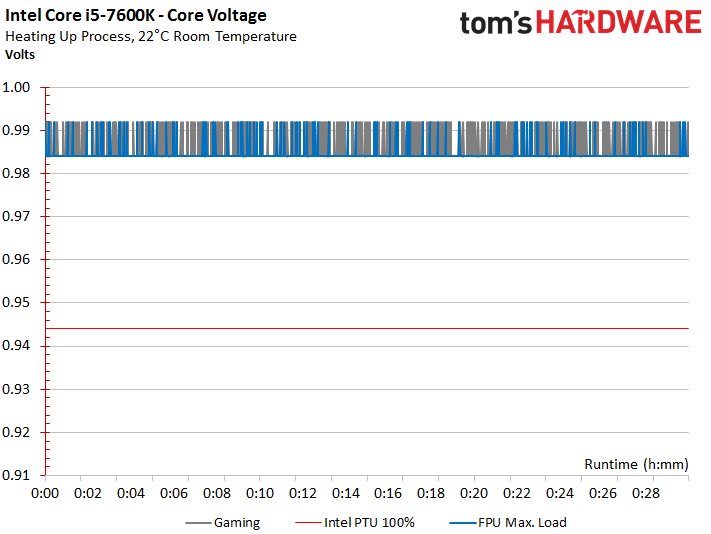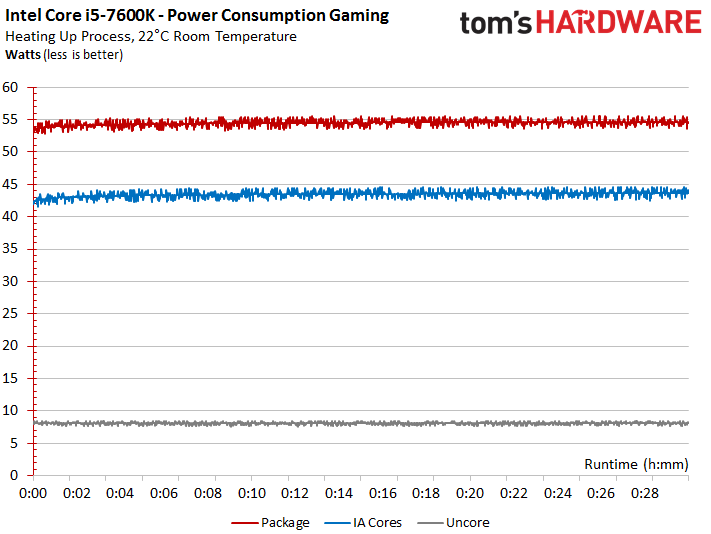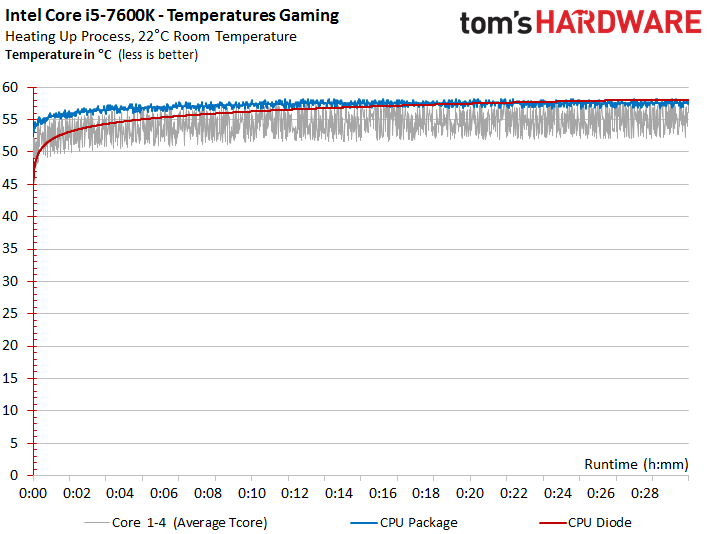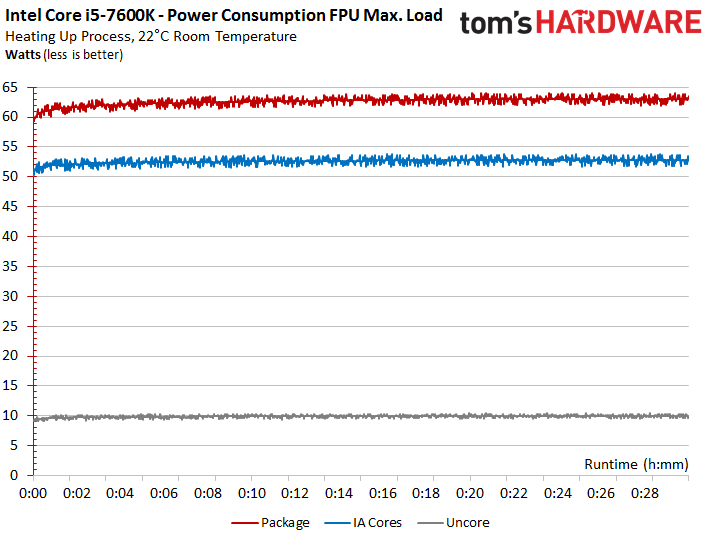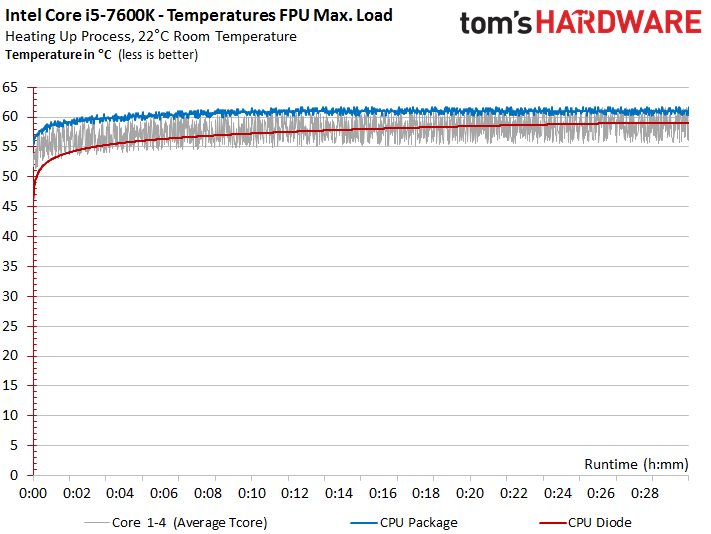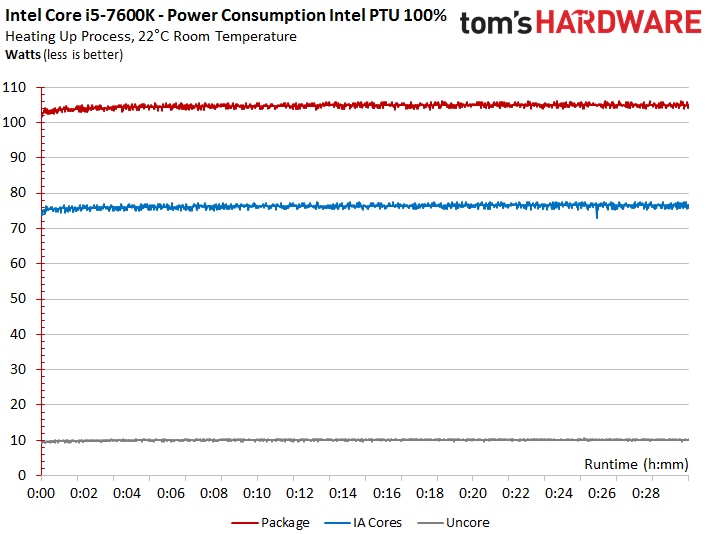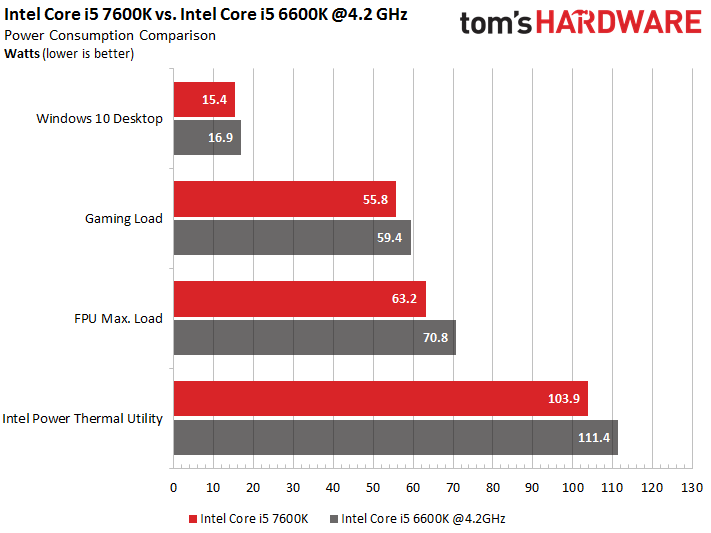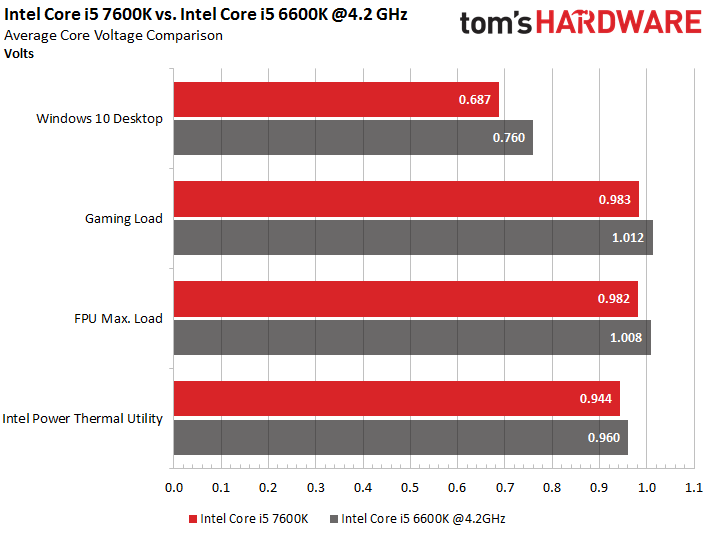Intel Kaby Lake Core i7-7700K, i7-7700, i5-7600K, i5-7600 Review
Intel Core i5-7600K: Power Consumption And Temperatures
Being a “K” model, the Core i5-7600K naturally has an unlocked multiplier and a higher base clock rate than the non-K model, just like the Core i7-7700K. This makes overclocking much more accessible.
The stock base frequency is 3.8 GHz. Still, our Core i5-7600K manages to run all four of its cores at a Turbo Boost rate of 4.2 GHz under heavy load.
Core Voltage (Vcore)
It’s plain to see that the voltage decreases as the loads increase. This is necessary so that the Intel Core i5-7600K’s maximum leakage currents aren’t exceeded. And as before, the more taxing the load, the less the curve fluctuates.
Normal Load: Gaming
Using the same Watch Dogs 2 gaming load, we measure an average of 54 to 56W for the entire CPU. That's well below Intel’s 90W TDP for this processor. It’s also a generally good result. The IA cores on their own account for 45W, with the rest being consumed by other parts of the CPU.
Once again, the CPU’s power consumption increases along with its temperature. This results in additional leakage currents of up to 2.2W.
The rate of temperature increase over time depends on the position of the sensor. Our measurements stabilize after more than 25 minutes.
Heavy Load: Stress Test (Floating Point Unit)
AIDA64's stability test yields a power consumption reading of 64W. Temperature and leakage current increases are similar to what we saw during the gaming workload.
Get Tom's Hardware's best news and in-depth reviews, straight to your inbox.
The Tcore increases noticeably up to 61°C. Other than that, the picture still looks a lot like what we saw while gaming. Again, simple air coolers shouldn't have a problem dealing with this amount of waste heat.
Maximum Load: Intel Power Thermal Utility (100%)
Power consumption increases substantially when the Core i5-7600K is pushed to its limit by Intel’s Power Thermal Utility. The 104W we measured far exceeds this CPU's TDP. Still, though, the increase in leakage current doesn’t affect power by more than 2W comparing the cold and warmed-up operating states.
The temperature results show us that the on-die diode stays a bit cooler than the other parts, whereas the package sensor displays the highest temperatures. Readings between 88°C and 89°C are right on the edge of what can still be considered acceptable.
Intel Core i5-7600K vs. Intel Core i5-6600K @ 4.2 GHz
We had two Skylake-based CPUs compete in the performance benchmarks after overclocking them to match Kaby Lake. The intention was to let us compare their IPC throughput. But power consumption is another good indicator of changes between processor generations. And there are substantial changes to observe, so long as you have a decent CPU sample!
A direct comparison across four scenes with different loads shows that the new CPU generation’s power consumption is significantly lower at the same performance level compared to the previous generation. This difference gets larger under more intensive workloads.
This is likely due to Intel’s improved manufacturing process, which allows the new chips to operate at much lower voltages. Results from our sensors would seem to validate this theory. Then again, there’s a question mark as well. The comparison between Intel's Core i7-7700K and Core i7-6700K at the same frequency showed the latter exhibiting lower overall power consumption in spite of its higher Vcore.
We said it before, and we feel the need to reiterate: there’s a lot of variability in CPU quality, which can impact these results specifically. We only had one CPU sample each, so this comparison’s really more of a case study. We'll go into more depth on this shortly.
Compared to the Core i7-7700K we tested previously, it looks like we ended up with a better Core i5-7600K. Again, this chip appears to have some thermal and performance reserves available to overclockers, so long as you aren't subjecting the chip to worst-case workloads.
Current page: Intel Core i5-7600K: Power Consumption And Temperatures
Prev Page Intel Core i7-7700: Power Consumption And Temperatures Next Page Intel Core i5-7600: Power Consumption And Temperatures
Igor Wallossek wrote a wide variety of hardware articles for Tom's Hardware, with a strong focus on technical analysis and in-depth reviews. His contributions have spanned a broad spectrum of PC components, including GPUs, CPUs, workstations, and PC builds. His insightful articles provide readers with detailed knowledge to make informed decisions in the ever-evolving tech landscape
-
Based on our initial testing, we can confirm that HD Graphics 630 does not function correctly under Windows 7 and 8.1. Both operating systems install generic drivers for the display adapter, even after applying the latest drivers and updates, so many core features remain unavailable. We also experienced stability issues with Windows 7 that might even negate using an add-in GPU as a workaround.Reply
Not true, i setup Kaby Lake in my lab and everything works fine under Windows 7. Did you guys even try to apply drivers for HD Graphic 630? -
adgjlsfhk It would have been kind of nice to see igpu vs gtx 750 and other low end discrete graphics cards, but other than that, great review.Reply -
cknobman Boooooooooooooooooring.Reply
Bring on the new AMD cpu's!!!
Oh, nice review the boring is not Toms fault ;) -
Jim90 "Intel’s slow cadence of incremental upgrades hasn’t done much to distance its products from AMD's.Reply
"...Obviously we need a competitive AMD to help reinvigorate the desktop PC space."
Without real competition the only risk Intel takes with the Desktop market is to loose sight of (i.e. actively ignore) the performance jump the consumer expects in a new release. Continual and lengthy minor incremental updates (pretty much what we've seen since the 2000 series) may well lead to consumer apathy. I certainly haven't upgraded 'as much as I could!' recently. Absolutely no justifiable need.
Then again, perhaps we've all had access to enough power we need? We used to talk about 'killer apps/software' to drive consumers into making a purchase. This certainly did work. Maybe new tech (currently available) isn't killer enough? We need another '3dfx Voodoo' experience?
VR is certainly (definite?) a potential driver...here's hoping for speedy and significant updates here. -
Paul Alcorn Reply19098433 said:Based on our initial testing, we can confirm that HD Graphics 630 does not function correctly under Windows 7 and 8.1. Both operating systems install generic drivers for the display adapter, even after applying the latest drivers and updates, so many core features remain unavailable. We also experienced stability issues with Windows 7 that might even negate using an add-in GPU as a workaround.
Not true, i setup Kaby Lake in my lab and everything works fine under Windows 7. Did you guys even try to apply drivers for HD Graphic 630?
Hello, yes we did test and attempt to install the HD Graphics 630 drivers. We are working with early BIOS revisions, so it is possible that we encountered a platform-specific issue. Can you share which motherboard you used for your testing? Any feedback is welcome.
-
ohim Why are they even releasing this ? It makes absolutely no sense to release such a product ...Reply -
redgarl Reply19098782 said:Why are they even releasing this ? It makes absolutely no sense to release such a product ...
Probably to make a statement of some kind.
-
FormatC Reply
You really have drivers for the Z270 chipset with official support of Windows 7 from intel and Microsoft? I tried it also and was not able to run KL with all features on a W7 installation. It runs, somehow. :)19098433 said:Not true, i setup Kaby Lake in my lab and everything works fine under Windows 7. Did you guys even try to apply drivers for HD Graphic 630? -
valeman2012 Just notice that people that are using these CPU you need Windows 10 to have everything working 100%.Reply

